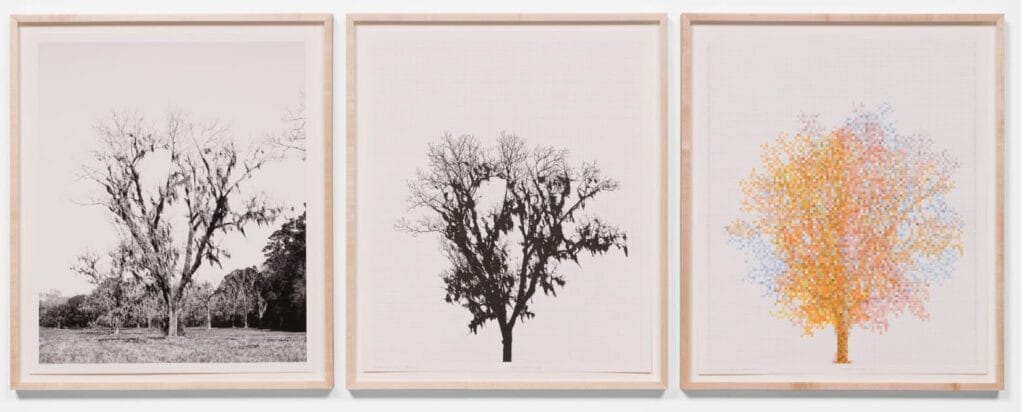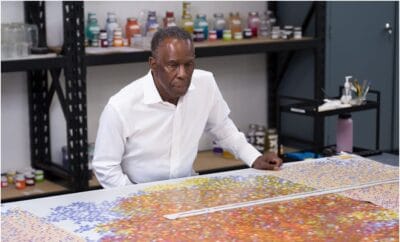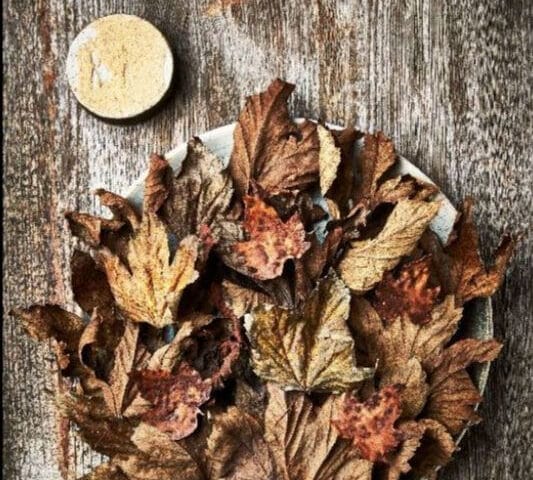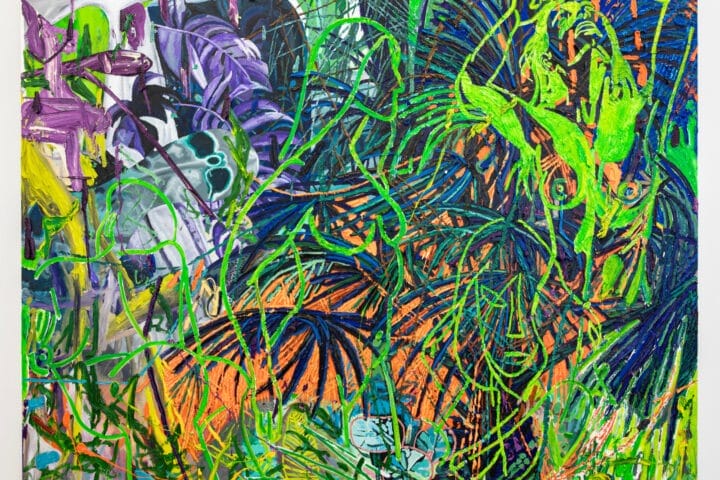New York… Hauser & Wirth presents ‘Southern Trees,’ the gallery’s first New York exhibition with distinguished American artist Charles Gaines and his first in the city since 2018. One of the most important conceptual artists working today, the show explores the evolution of Gaines’s complex practice, demonstrating how he has continued to forge new paths within the innovative framework of two of his most acclaimed series, Numbers and Trees and Walnut Tree Orchard. The exhibition’s title, ‘Southern Trees,’ alludes directly to the 150-year-old pecan trees pictured in the new works, and symbolically to the opening lyrics of ‘Strange Fruit,’ Billie Holiday’s haunting protest anthem from the 1930s.
The image of the tree has been central to Gaines’s practice since he first began the Walnut Tree Orchard series in the 1970s. In ‘Southern Trees,’ Gaines advances the series using pecan trees photographed on a visit to Boone Hall Plantation in Charleston County, South Carolina––not far from where the artist was born and lived until he was five years old. Presented alongside a key early example from the walnut tree series, eight new triptych works on paper revisit and expand upon this significant original body of work.

‘Walnut Tree Orchard: Set M’ (1977), on loan from the Whitney Museum of American Art, New York, pairs a black and white photograph of a walnut tree with two drawings derived from it––an ink outline of the same tree and a grayscale grid that plots all of the trees included in the series up until that point. The newest series, titled Pecan Trees (2022), begins similarly, with a stark black and white photograph of a tree; yet in the drawings that accompany it, Gaines has filled in the outline of the tree with solid ink and used vibrant watercolors to plot all the previous trees in the final drawing. These successive modifications to scale, color and background demonstrate Gaines’s theory that while ‘the system has never changed, the outcome is always different.’
This extends to Gaines’s new Numbers and Trees Plexiglas series, which begin with the artist assigning each tree a distinctive color and numbered grid––breaking down the composition into individual cells that reflect the full form of the tree depicted in the photograph on the surface. However, Gaines reverses his signature process in this new series by overlaying the forms of the trees one at a time and in progression on the back panel of the work rather than on the front. He then brings the photograph to the surface by printing an enlarged detail of the most recently added tree on the work’s Plexiglas surface. This approach brings the tree’s shadowy branches to the foreground, highlighting its textural details and contrasting tones while obscuring the colorful numbered grids painted underneath it. This reversal produces a dramatically different effect, igniting a more somber, yet stirring, reaction to the work as the austere branches, dripping with moss, dominate the picture.
Created through carefully considered systems rather than through the artist’s own imagination or intuition, these new works remove the artist’s subjectivity by following a set of self-determined rules and procedures. The works call into question both the objective nature of the trees and the subjective natural and material human actions that surround them. The fastidious layering process allows Gaines to reveal the differences between the trees’ shapes where the forms do not align. These differences, highlighted by the artist’s systems, suggest the arbitrary nature of other manufactured systems in our society––such as politics, gender, race and class.
About the Artist

Charles Gaines (b. 1944, Charleston SC) lives and works in Los Angeles. He recently retired from the CalArts School of Art, where he was on the faculty for over 30 years and established a fellowship to provide critical scholarship support for Black students in the M.F.A. Art program. Gaines has been the subject of numerous exhibitions in the United States and around the world, most notably a mid- career survey at the Pomona College Museum of Art and the Pitzer College Art Gallery in Claremont CA, as well as a museum survey of his Gridwork at The Studio Museum, Harlem NY and the Hammer Museum, Los Angeles CA.
Gaines’s work is included in prominent public collections such as the Museum of Modern Art, New York NY; Whitney Museum of American Art, New York NY; The Studio Museum, Harlem NY; Hirshhorn Museum and Sculpture Garden, Washington DC; Museum of Contemporary Art, Chicago IL; Hammer Museum, Los Angeles CA; Los Angeles County Museum of Art, Los Angeles CA; Museum of Contemporary Art, Los Angeles CA; San Francisco Museum of Modern Art, San Francisco CA; and Tate, London, UK. His work has also been presented at the 1975 Whitney Biennial and the Venice Biennale in 2007 and 2015.
In 2022 Gaines launched his most ambitious public art project yet, ‘The American Manifest,’ presented by Creative Time, Governors Island and Times Square Arts. Unfolding in three parts over the course of two years and across three sites, the work features both performance and large-scale sculptural works to tell the complicated story of the over 400-year settlement of the United States, focusing on the country’s foundations of colonialism, racial capitalism, democracy, and the legacy of Manifest Destiny. In Summer 2023, the third chapter of ‘The American Manifest’ will be staged on the banks of the Ohio river. On 1 December 2023, The Institute of Contemporary Art, Miami, will open a major survey of the artist’s work from 1992 to the present, tracing the complex interrelation of formal innovation, conceptual rigor and political content that has characterized the second half of his career. An exhibition of his work is also currently on long term view at Dia:Beacon in New York. In addition to his artistic practice, Gaines has published several essays on contemporary art, including ‘Theater of Refusal: Black Art and Mainstream Criticism’ (University of California, Irvine, 1993) and ‘The New Cosmopolitanism’ (California State University, Fullerton, 2008). In 2019, Gaines received the 60th Edward MacDowell Medal. He was inducted into the National Academy of Design’s 2020 class of National Academicians and the American Academy of Arts and Letters in May 2022.
Hauser & Wirth
542 W 22nd St, New York, NY 10011









